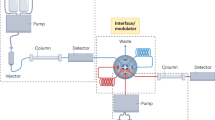Abstract
IT is reasonable that a gas chromatographic apparatus can be arranged in a circular form. Fig. 1 shows a chromatographic column connected head to tail. In operation, the carrier gas is brought to a desired initial pressure using the stopcock arrangement that is also utilized for sampling. The pump in the circuit is used to circulate the carrier gas previously introduced. Simple laboratory peristaltic-type pumps have been found satisfactory for circulating the gas stream. A bleed stream of carrier gas from a separate source is used in the reference side of a resistance-wire thermal-conductivity detector. The columns are packed with crushed insulating brick of conventional size. Temperature control is accomplished by either liquid or air baths.
This is a preview of subscription content, access via your institution
Access options
Subscribe to this journal
Receive 51 print issues and online access
$199.00 per year
only $3.90 per issue
Buy this article
- Purchase on Springer Link
- Instant access to full article PDF
Prices may be subject to local taxes which are calculated during checkout
Similar content being viewed by others
Author information
Authors and Affiliations
Rights and permissions
About this article
Cite this article
PORTER, R., JOHNSON, J. Circular Gas Chromatograph. Nature 183, 391–392 (1959). https://doi.org/10.1038/183391a0
Issue Date:
DOI: https://doi.org/10.1038/183391a0
This article is cited by
-
Generic Ultrahigh Resolution HPLC Methods: An Efficient Way to Tackle Singular Analytical Problems in Industrial Analytics
Chromatographia (2017)
-
Neuere Entwicklung der Gaschromatographie
Die Naturwissenschaften (1960)
-
Volatile Liquid Partition Chromatography
Nature (1959)
Comments
By submitting a comment you agree to abide by our Terms and Community Guidelines. If you find something abusive or that does not comply with our terms or guidelines please flag it as inappropriate.



